Areas where Liposuction can be performed
With liposuction, you can get rid of excessive fat from the following areas:
- Face & Neck
- Breast or Chest area
- Abdomen and waist
- Back
- Hips and buttocks
- Upper arms
- Thighs
- Inner knee
- Calves and ankles

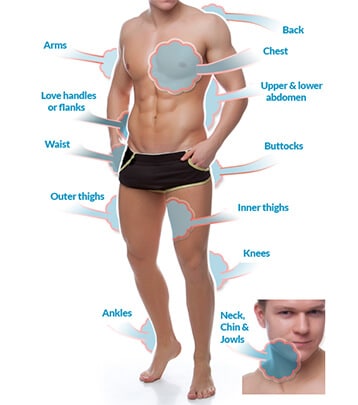
Liposuction is most commonly performed on abdomen among both men and women. The accumulation of fat in the abdomen is often simply a fact of heredity and is especially resistant to diet and exercise. Liposuction in such individuals can successfully produce a slender, overall proportional shape.The success of abdominal liposuction depends upon the amount and location of the fat and also the amount of intra-abdominal fat. It also depends on the age, sex, skin elasticity, and history of pregnancy. In case of previous pregnancy, the abdominal muscles and the overlying skin stretch causing the lower abdomen to bulge out. In such patients with muscle diastasis and abdominal wall laxity, additional skin excision and/or muscle plication may be required in order to achieve an optimal contour and aesthetic result.
women. The accumulation of fat in the abdomen is often simply a fact of heredity and is especially resistant to diet and exercise. Liposuction in such individuals can successfully produce a slender, overall proportional shape.The success of abdominal liposuction depends upon the amount and location of the fat and also the amount of intra-abdominal fat. It also depends on the age, sex, skin elasticity, and history of pregnancy. In case of previous pregnancy, the abdominal muscles and the overlying skin stretch causing the lower abdomen to bulge out. In such patients with muscle diastasis and abdominal wall laxity, additional skin excision and/or muscle plication may be required in order to achieve an optimal contour and aesthetic result.
Success of Liposuction of Abdominal fat:
Abdominal fat occurs in two levels:
- Subcutaneous fat located beneath the skin and above the muscles. This fat can be removed with liposuction.
- Deep/intraabdominal fat located inside the abdominal cavity around the intestines. This fat cannot be removed by liposuction. This fat can only diminish with diet & exercise.
Most people have more subcutaneous fat than intestinal fat and thus liposuction procedure can help achieve optimum results in them.
Males and females have varied distribution of fat in the thigh region. Women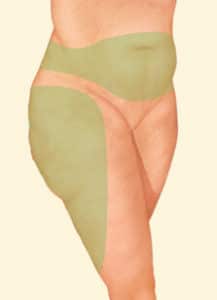 tend to accumulate fat in a circumferential manner or more in medial and lateral areas, whereas, men tend to accumulate fat in the proximal thighs. Fat on thighs and hips is largely determined by inherited genetics, and it is often resistant to exercise and dieting. Fat thighs tend to convey an image of an inactive lifestyle, and self-conscious embarrassment. In contrast, long slender thighs suggest youth, athleticism, and vitality.
tend to accumulate fat in a circumferential manner or more in medial and lateral areas, whereas, men tend to accumulate fat in the proximal thighs. Fat on thighs and hips is largely determined by inherited genetics, and it is often resistant to exercise and dieting. Fat thighs tend to convey an image of an inactive lifestyle, and self-conscious embarrassment. In contrast, long slender thighs suggest youth, athleticism, and vitality.
Some patients have “two body syndrome” where the thighs can be so large that when a woman is buying clothing, she is forced to buy different sized tops and bottoms in order to properly fit the upper and lower body. For such women, liposuction is a dream come true.
Liposuction of the entire thigh during one day is not recommended. Circumferential liposuction in a single stage often results in a prolonged swelling of the feet and legs, with significantly more discomfort and delayed return to normal activities. It may also predispose the patient to deep vein thrombosis. The cause of leg swelling after circumferential liposuction is injury to the lymphatic vessels found in fatty tissue. The portion of the thigh that is not treated provides functioning lymphatics that compensate for the impaired lymphatic drainage in the treated area.
Inner Thighs and Inner Knees
Inner thigh liposuction can significantly improve the silhouette of the thigh and reduce the rubbing together of the inner thighs. Fat in the medial thigh is soft and the overlying skin is thin and often lax. Women who have good skin elasticity can expect excellent results the following liposuction. When the medial thigh skin is excessively wrinkled and saggy, liposuction may not provide a satisfactory degree of improvement. In fact liposuction may worsen the degree of wrinkling. Prospective patients should be informed that liposuction may be expected to improve the shape of the thigh while at the same time exacerbate the wrinkled appearance of the skin.
Inner thighs liposuction is often combined with knee liposuction. Lipodystrophy around the knees is usually confined to medial and anterior region. The combined procedure gives smoother results and shape to the thigh.
Anterior thigh
The anterior thigh is characterized by compact fat of limited thickness. Patients often have more fullness proximally compared with the distal anterior thigh. Contouring of this area helps eliminate step off or transition points from the medial and lateral thighs and helps decrease the projection of the thigh in the posterior to anterior view. The anterior and medial thigh is often addressed in the same sitting.
Lateral thighs
The lateral thigh is likely the site of the most contour irregularities; the visibility of the lateral thigh, as well as the possibility for skin laxity, contribute to this. Extreme caution is required for fear of worsening preexisting contour irregularities and thus requires expertise.
Posterior thighs
The prominent banana-shaped bulge of fat on the upper posterior thigh immediately below the buttock is often regarded as a cosmetic “defect.” When attempting to treat this banana-shaped bulge by liposuction, it is very easy for the surgeon to do too much liposuction and create an extra horizontal infra-gluteal crease. The banana fold is always liposuctioned superficially. If suctioned deeply, the fibrous structures that hold the buttock in place will be broken, and this will result in a lengthening of the buttock.
The fat distribution and proportion on female legs and ankles is genetically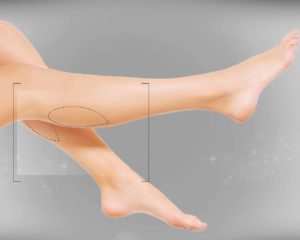 predetermined. The fat on legs & ankles is superficial fat and is usually resistant to diet and exercise.
predetermined. The fat on legs & ankles is superficial fat and is usually resistant to diet and exercise.
The fat on the legs is relatively superficial fat. It is not recommended to remove excessive fat from the legs and ankles, as it increases the risk of blood vessel injury. Over excision of fat can result in irregularities in the skin producing lumpiness and bumpiness. The aim of liposuction on the legs should be natural looking and aesthetically pleasing contours and hence excessive liposuction should be avoided.

Buttock shape is different in males and females. In females, the silhouette forms a smooth curve from the waistline onto the hips and legs without sharp edges, whereas in men it is sharp-edged by definition. The form of female buttocks is almost hemispherical, whereas in men it tends to be square. Buttock contouring most often involves fat grafting and fat redistribution rather than suction alone. Buttockliposculpting is often combined together with thigh and lower back liposuction for a more proportionate and cosmetically pleasing result.
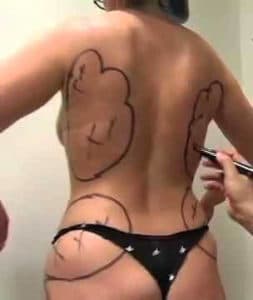
The anatomy of the subcutaneous fat and skin in this region is unique; it has a very thick dermis and a dense, fibrous characteristic to the underlying fat. These qualities make liposuction with traditional SAL difficult in the back region. Modalities such as UAL/PAL tend to work well in the fibrous tissue of the back. The quantity of fat removed can be moderate, but improved results are often seen with release of folds and attachments to deeper tissue. Women will often complain of fat along the roll of bra-line and large pockets of lipodystrophy can be seen. This area responds especially well to UAL allowing the fold to be broken up and excess fat removed.
The arm is divided into four regions: anterior, external, posterior and internal where the fat is mainly of superficial type (a thin layer). For contouring, the most important region is the posterior arm, where there is also a deep layer of fat.Since these areas of the arms aren’t where the muscles lie, toning exercises and dieting have no real effect on these so-called “arm flaps,” so for many, liposuction is the best and easiest remedy. The most common cosmetic problem associated with liposuction of the arms is excessive and uneven removal of fat. Arms that are devoid of subcutaneous fat are not attractive and do not look like normal arms. Some patients will present with the ‘‘bat wing’’ deformity and nonretractable skin, unlikely to be improved with liposuction. Arm lift is required for such patients and it is emphasized that liposuction thins, it does not tighten or lift!
where the fat is mainly of superficial type (a thin layer). For contouring, the most important region is the posterior arm, where there is also a deep layer of fat.Since these areas of the arms aren’t where the muscles lie, toning exercises and dieting have no real effect on these so-called “arm flaps,” so for many, liposuction is the best and easiest remedy. The most common cosmetic problem associated with liposuction of the arms is excessive and uneven removal of fat. Arms that are devoid of subcutaneous fat are not attractive and do not look like normal arms. Some patients will present with the ‘‘bat wing’’ deformity and nonretractable skin, unlikely to be improved with liposuction. Arm lift is required for such patients and it is emphasized that liposuction thins, it does not tighten or lift!
Arm liposuction can be combined with liposuction of anterior axillary fat pads and posterior axillary fat pads which tend to bulge unattractively above the bra.
Anterior Axillary Fat Pads, located on the chest just in front of the armpit become more prominent with age and in case of obesity. Some thin women may also have relatively large anterior axillary fat pads.
Posterior Axillary Fat Pads are located right behind the armpit on the side of the back.
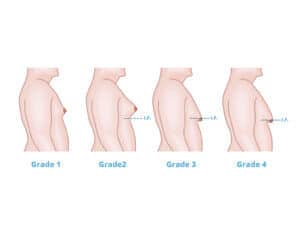
Gynaecomastia is the development of excess breast tissue in the male-a very common pathology but a source of embarrassment. It presents as firm tissue underlying the nipple and can be graded as
Grade 1-small breast development but with no redundant skin
Grade 2a-moderate breast development with no redundant skin
Grade 2b– moderate breast development with redundant skin
Grade 3– marked breast development with much redundant skin
Before the advent of liposuction, all gynaecomastia were treated surgically which resulted in unpleasant scars. But now in almost all cases, liposuction alone is sufficient and can be done to improve the patient’s physical appearance by removing the fat and the glandular tissue from the male breast. Newer technologies like power-assisted liposuction help in breaking the fibrous breast gland which can then be delivered piecemeal through a small incision.The result is a minimal scar surgery with faster recovery.
Very rarely, when the gland is too fibrous, an additional periareolar incision from 3 to 9 o’ clock might be required to excise the gland. Redundant skin improves spontaneously by postoperative shrinkage but in certain higher grades, excision of excess skin may be required which may then involve additional scars around the areola.
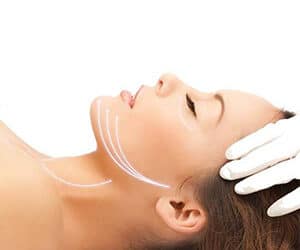
Liposuction is considered the safest and most effective procedure for fat removal from the face and neck. It can remove unwanted fat from under the chin and neck, thus eliminating jowls, a double chin, or so-called “turkey neck. The ideal candidate has a localized pocket of fatty tissue refractory to weight loss +/_ minimal to mild skin laxity. Younger patients have greater skin elasticity which contracts better and are ideal for such lipo contouring. Loss of skin elasticity and turgor in older patients necessitates the combination of a skin tightening procedure/face lift.
The term flank describes an area immediately superior and posterior to the hip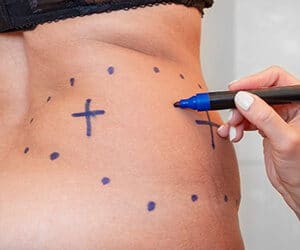 bone. Suctioning in this area can provide excellent results, and all modalities have proven effective. The fat is loose and in some cases fibrous, with thick overlying skin. Significant striae may be seen in patients with weight fluctuations or in postpartum women. Liposuction in these patients may reduce the lipodystrophy but may result in superficial contour irregularities or skin redundancy. When performing liposuction of the hips and flanks, knowledge of the differing aesthetic consideration in males and females is crucial to preventing inappropriate masculinization or feminization and hence this procedure should be performed by a trained plastic surgeon.
bone. Suctioning in this area can provide excellent results, and all modalities have proven effective. The fat is loose and in some cases fibrous, with thick overlying skin. Significant striae may be seen in patients with weight fluctuations or in postpartum women. Liposuction in these patients may reduce the lipodystrophy but may result in superficial contour irregularities or skin redundancy. When performing liposuction of the hips and flanks, knowledge of the differing aesthetic consideration in males and females is crucial to preventing inappropriate masculinization or feminization and hence this procedure should be performed by a trained plastic surgeon.

